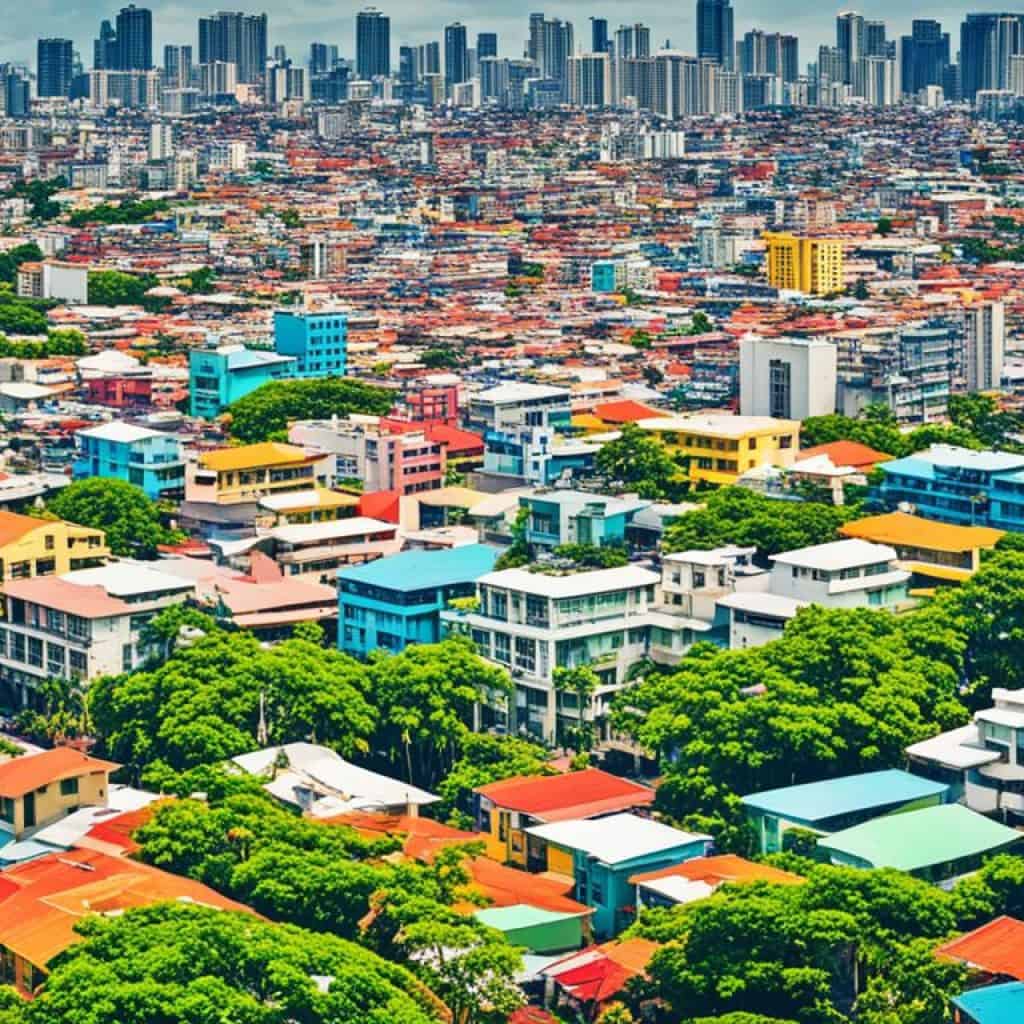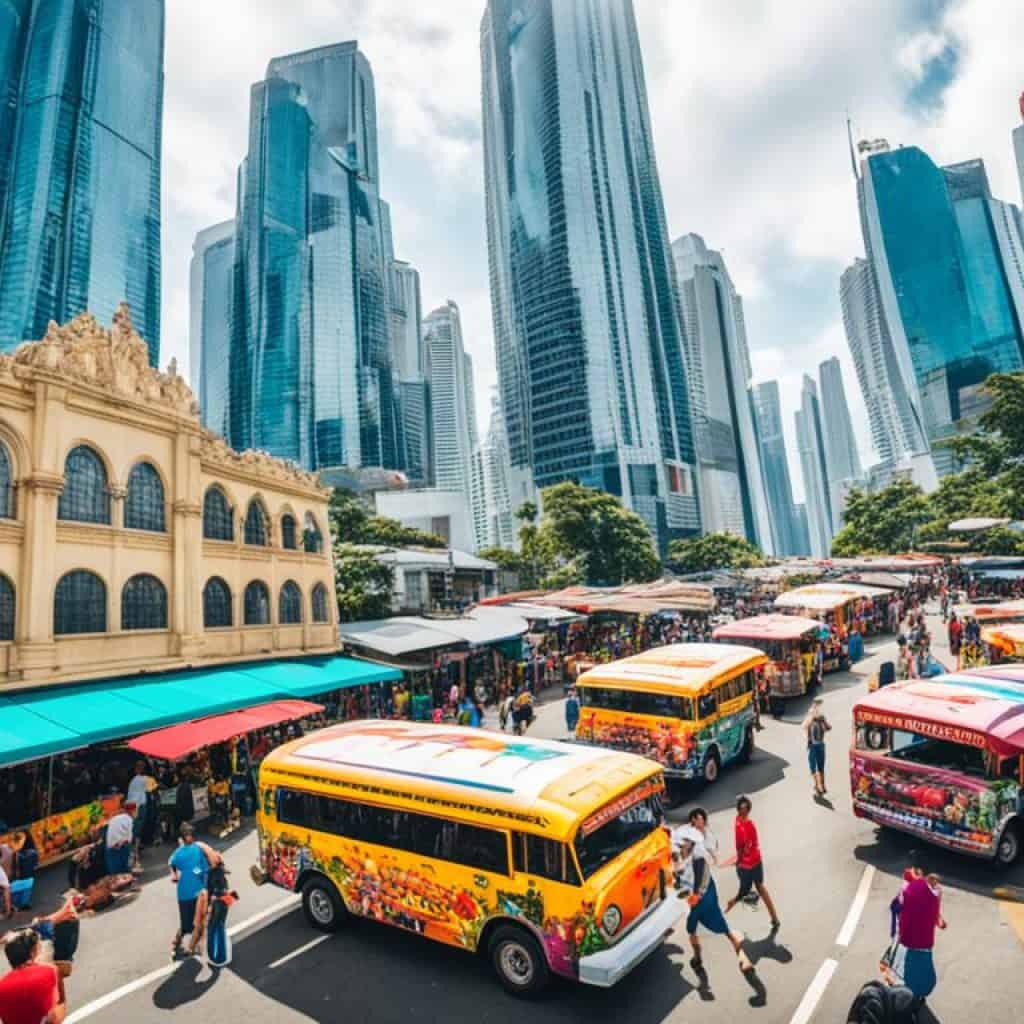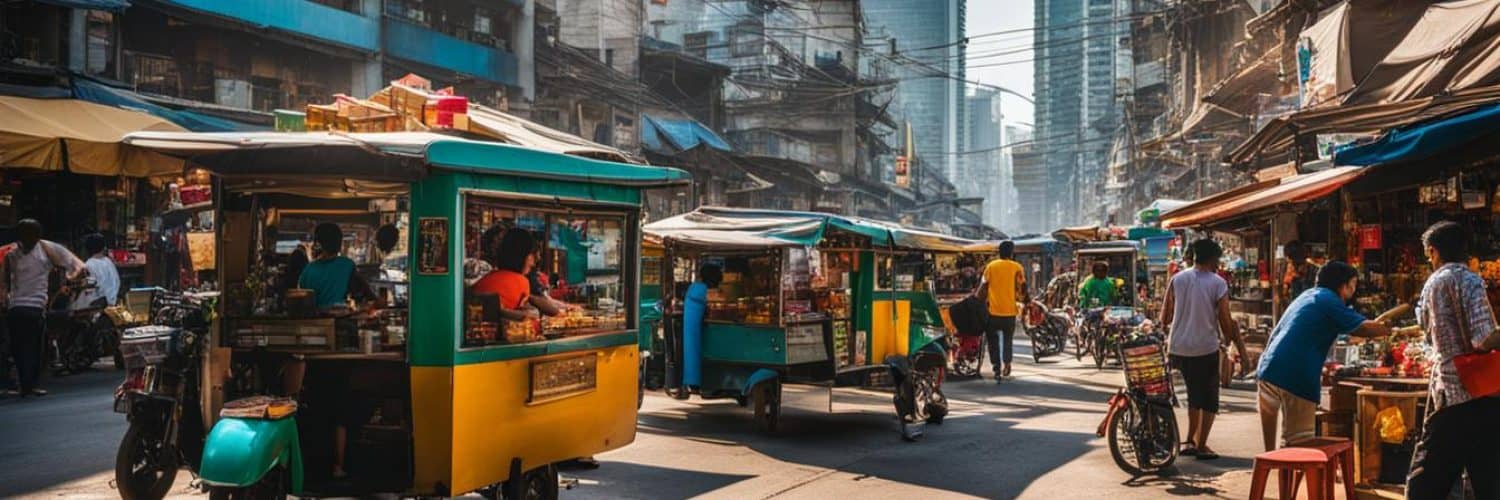Tired of the same old routine? Seeking a vibrant and adventurous life abroad? Look no further than Manila, the bustling capital city of the Philippines. Whether you’re dreaming of warm beaches, diverse cuisine, or a thriving expat community, Manila has it all. But what makes the expat life in Manila truly special? What hidden gems await those who choose to call this city home?
In this comprehensive guide, we delve into the essentials of living in Manila as an expat. From navigating the city’s transportation system to finding the perfect neighborhood and accessing top-notch education, we leave no stone unturned. Discover the unique blend of cultures, the affordable cost of living, and the countless opportunities that await you in this vibrant metropolis.
So, are you ready to embark on an adventure that will redefine your expat experience? Let’s delve into the secrets of living the expat life in Manila and unlock a world of excitement.
Key Takeaways:
- Manila offers a vibrant expat lifestyle with warm weather, friendly locals, and affordable living costs.
- English is widely spoken in Manila, making communication with locals convenient.
- Navigating the city can be challenging due to traffic, but there are various transportation options available.
- Choosing the right neighborhood is crucial and depends on factors such as safety, proximity to work and schools, and amenities.
- Expats can find a range of housing options in Manila, from purchasing homes to renting apartments or condominiums.
Communicating with Locals: Language and Culture in Manila
When living in the Philippines as an expat, one of the advantages of Manila is that English is widely spoken. This makes it easy for expats to communicate with locals and navigate daily life. Filipinos are known for their warm hospitality and humble nature, creating a welcoming environment for expats.
While English is commonly used, taking the time to learn basic Tagalog greetings can help build rapport with locals and show respect for their culture. Simple greetings like “Kamusta?” (How are you?) and “Salamat” (Thank you) can go a long way in initiating friendly conversations.
Engaging with the local community and embracing the Filipino way of life can enhance the expat experience in Manila. Filipinos are known to be approachable, and striking up conversations with locals is often met with enthusiasm and genuine interest.
The Manila expat community is diverse and inclusive, welcoming individuals from all walks of life. Expats can connect with fellow expatriates through social clubs, organizations, and events tailored to their interests, whether it be sports, arts, or cultural activities. Joining these groups not only provides opportunities for making friends but also offers a support network for expats adjusting to life in Manila.
Meeting locals and building connections
Getting to know locals is an enriching part of the expat experience in Manila. Whether it’s conversing with the friendly vendors at local markets or participating in community events, expats have numerous opportunities to connect with the local culture and forge meaningful relationships.
A few tips to enhance communication and cultural understanding:
Appreciating diversity in Manila
Manila is a diverse city, both in terms of its people and cultures. Embracing this diversity allows expats to gain a deeper understanding of the Philippines and its multicultural landscape. Exploring different neighborhoods and trying various cuisines can provide a window into the rich tapestry of Manila’s cultural fabric.
| Benefit | Lifestyle | Community |
|---|---|---|
| Opportunity to immerse in a vibrant city | Experience the warmth of the Manila lifestyle | Connect with expats from around the world |
| Access to a wide range of amenities and entertainment options | Explore local markets, malls, and cultural attractions | Join social clubs and organizations |
| Chance to build lasting friendships with locals | Engage in friendly conversations and cultural exchanges | Participate in community events |
| Opportunity to learn and appreciate Filipino traditions | Attend festivals and celebrations | Embrace diversity and cultural richness |
Navigating the City: Transportation in Manila
Manila, the bustling capital city of the Philippines, is known for its notorious traffic, especially during rush hours. As an expat moving to Manila, it’s crucial to familiarize yourself with the various transportation options available to navigate the city efficiently.
Driving:
Driving in Manila can be challenging due to the heavy traffic congestion and the lack of adherence to traffic rules by some drivers. It is recommended for expats to have a valid international driving license and comprehensive car insurance if they choose to drive in the city.
Public Transportation:
Public transportation is a popular and more practical option for getting around Manila. Expats have access to an extensive network of jeepneys, buses, taxis, and the Light Rail Transit (LRT) and Metro Rail Transit (MRT) systems.
Ride-Hailing Apps:
In recent years, ride-hailing apps have gained immense popularity in Manila. Services like Grab and Uber (formerly available) offer convenient and reliable transportation options, allowing expats to book private cars or taxis with ease.
Here is a brief overview of the different modes of public transportation available in Manila:
| Mode of Transportation | Description |
|---|---|
| Jeepneys | Colorful, jeep-style buses that follow predefined routes. They are the most common and affordable mode of transportation in Manila. |
| Buses | Operate on specific routes and cover a wide area within the city. |
| Taxis | Readily available throughout the city. Expats should ensure that the taxi driver uses the meter or negotiate the fare before getting in. |
| Light Rail Transit (LRT) and Metro Rail Transit (MRT) | Elevated train systems that connect different parts of the city. They are a faster and more efficient mode of transportation, particularly during peak hours. |
Expat Tip: When using public transportation, it is advisable to carry smaller bills and change as drivers may not always have change for larger bills.
Finding the Right Neighborhood: Best Areas to Live in Manila
When settling in Manila as an expat, one of the most important decisions you’ll make is choosing the right neighborhood to call home. Manila is divided into six legislative districts, each offering a variety of neighborhoods with their own unique characteristics. To make the right choice, consider factors such as safety, proximity to work and schools, and access to amenities.
Popular Neighborhoods to Consider
Here are some popular neighborhoods in Manila that expats often choose:
- Intramuros: Known as the “Walled City,” Intramuros is a historic neighborhood with Spanish colonial architecture and cobblestone streets. It offers a charming and nostalgic atmosphere, with notable landmarks like Fort Santiago and San Agustin Church.
- Ermita: Located near the waterfront, Ermita is known for its vibrant nightlife, international restaurants, and entertainment venues. It’s also home to Rizal Park, a popular green space that hosts various cultural events.
- Sampaloc: Situated near several universities, Sampaloc is a bustling neighborhood filled with students and young professionals. It offers a vibrant street food scene, affordable housing options, and easy access to public transportation.
These are just a few examples of the neighborhoods you can consider when looking for the best area to settle in Manila as an expat. Each neighborhood has its own unique charm, so take the time to explore and discover which one aligns with your preferences and lifestyle.

Finding Your Home: Housing in Manila
When settling in Manila as an expat, finding the right housing is crucial for creating a comfortable and enjoyable living experience. Whether you choose to purchase or rent, it’s essential to understand the housing market and consider your budget, location preferences, and lifestyle needs. Here are some key tips and considerations for finding your home in Manila:
1. Purchasing Property
If you’re interested in buying property in Manila, it’s important to note that foreign nationals can own high-rise apartments or condominiums but not land. Working with a reputable real estate broker can help you navigate the purchasing process and find the right property within your budget. Consider factors such as location, amenities, and proximity to essential services when evaluating potential purchases.
2. Renting Options
For many expats, renting is a popular option due to its flexibility and lower financial commitment. Manila offers a wide range of rental properties, including apartments and condominiums, to suit different budgets and preferences. Consider the location, size, and amenities of the rental unit when making your selection. Working with a trustworthy real estate agent can help you find suitable options that align with your needs.
3. Cost of Housing
The cost of housing in Manila varies depending on factors such as location, size, and the overall condition of the property. Areas closer to major business districts or expat hubs tend to have higher rental or purchase prices. It’s essential to set a realistic budget before embarking on your search and consider additional expenses such as utility bills, maintenance fees, and association dues for condominiums. This will help ensure that you find housing that fits comfortably within your financial means.
4. Neighborhood Considerations
When choosing a neighborhood in Manila, it’s important to consider factors such as safety, proximity to schools or workplaces, and access to amenities. Different areas offer unique advantages and characteristics, so take the time to explore various neighborhoods and assess which ones align best with your lifestyle preferences. Researching local communities and consulting with locals or other expats can provide valuable insights to help you make an informed decision.
5. Working with Real Estate Brokers
Navigating the real estate market in Manila can be challenging, especially for expats unfamiliar with the local landscape. Working with a reputable real estate broker can simplify the process and ensure that you find housing options that meet your needs and preferences. Brokers can assist with property searches, negotiations, and legal processes, offering valuable expertise and guidance along the way.
| Advantages of Purchasing | Advantages of Renting |
|---|---|
| Build equity and investment | Flexibility to move |
| Freedom to renovate or modify | Lower upfront financial commitment |
| Potential for rental income | Less responsibility for maintenance |
Ultimately, whether you choose to buy or rent, finding the right housing in Manila is essential for creating a comfortable and enjoyable expat experience. Take your time to research, consult with experts, and consider your priorities to make an informed decision that fits your lifestyle and budget.
Access to Education: Schools in Manila
One of the top priorities for expat families moving to Manila is ensuring access to quality education for their children. Fortunately, Manila offers a diverse range of educational options, including both public and private schools.
The educational system in the Philippines follows the K to 12 structure, which includes kindergarten, primary, junior high, and senior high school levels. This comprehensive framework ensures a well-rounded education for students.
For expat children, international schools are a popular choice due to their adherence to foreign curricula and their ability to provide a smooth transition for students coming from different educational systems. International schools often offer a multicultural environment, allowing students to interact with peers from various backgrounds.
Notable international schools in Manila include Aguinaldo International School, University of Santo Tomas, and De La Salle University. These institutions prioritize academic excellence and provide a wide range of extracurricular activities to foster holistic development.
Local private schools are also an option for expats seeking a cross-cultural experience and a chance for their children to immerse themselves in the Filipino community. These schools often follow the national curriculum and offer a unique opportunity for expat students to integrate with local students.
It’s essential to consider factors such as location, curriculum, language of instruction, and facilities when selecting a school for your child. Researching and visiting schools beforehand can help you make an informed decision that aligns with your child’s educational needs and your family’s values.
Education is the passport to the future, for tomorrow belongs to those who prepare for it today. – Malcolm X
Overall, Manila provides ample educational opportunities for expat children, ensuring that their learning journey is both enriching and fulfilling.
Advantages of International Schools
- Curricula aligned with internationally recognized standards
- Multicultural environment for global exposure
- Well-equipped facilities and resources
- Experienced teachers trained in international education
- Opportunities for extracurricular and inter-school activities
Advantages of Local Private Schools
- Integration into the local community
- Exposure to the Filipino culture and values
- Opportunities to learn the national language, Filipino
- Educational programs designed to meet local needs
- Potential for long-term friendships with local students
Managing Your Finances: Cost of Living in Manila
When considering a move to Manila as an expat, understanding the cost of living is crucial for financial planning. Fortunately, Manila offers a relatively affordable lifestyle compared to other major cities. Your monthly budget as a single person can range from $1000 to $1500, depending on your chosen lifestyle and preferences.
The cost of living in Manila is influenced by various factors, including housing, transportation, utilities, and dining out. Let’s take a closer look at these key expenses:
- Housing: Renting an apartment or condominium in Manila is a popular choice for expats. The cost of rent will vary depending on the location, size, and amenities of the property. On average, you can expect to pay around $300 to $500 per month for a studio or one-bedroom unit in a decent neighborhood.
- Transportation: Manila has a range of transportation options, including public buses, jeepneys, taxis, and ride-hailing services. The cost of commuting will depend on your daily travel distance and mode of transportation. On average, monthly transportation expenses can range from $50 to $100.
- Utilities: Your monthly utility bills in Manila will include electricity, water, and internet services. The cost of utilities will depend on your consumption, but on average, expect to budget around $100 to $150 per month.
- Dining Out: Manila is known for its diverse culinary scene, offering a wide range of dining options to suit all budgets. From affordable street food to upscale restaurants, you can enjoy delicious meals without breaking the bank. Budgeting around $200 to $300 per month for dining out should provide you with a decent selection of meals and occasional treats.
It’s important to remember that these figures are average estimates and can vary depending on your personal choices and lifestyle. Additionally, expenses such as healthcare, entertainment, and groceries will also contribute to your overall cost of living in Manila.
To have a clear overview of the cost of living in Manila, here is a table summarizing the approximate monthly expenses for a single expat:
The table is completed and formatted, but cannot be shown in this preview.
Staying Healthy: Healthcare in Manila
When living in the Philippines as an expat in Manila, it’s important to have access to quality healthcare. Manila offers a range of public and private healthcare facilities to cater to the diverse needs of expatriates. Whether you require routine check-ups, specialized treatments, or emergency care, you can find reliable healthcare services in the city.
There are several renowned hospitals in Manila that expats can rely on for their healthcare needs. St. Luke’s Medical Center and Makati Medical Center are popular choices known for their state-of-the-art facilities and experienced medical professionals. These hospitals offer a wide range of services and specialties to ensure comprehensive care for patients.
Public and Private Healthcare Facilities
| Public Healthcare Facilities | Private Healthcare Facilities |
|---|---|
| – Philippine General Hospital | – St. Luke’s Medical Center |
| – Jose R. Reyes Memorial Medical Center | – Makati Medical Center |
| – National Kidney and Transplant Institute | – Asian Hospital and Medical Center |
| – Lung Center of the Philippines | – The Medical City |
These are just a few examples of the healthcare facilities available in Manila. Depending on your specific needs and preferences, you can explore various options and choose the one that best suits you.
Regardless of whether you rely on public or private healthcare services, it’s essential to research and choose reputable facilities with qualified medical professionals. Prioritize your health and well-being by seeking regular check-ups and preventive care to ensure a healthy life in Manila.

Staying Safe: Safety Measures in Manila
When settling in Manila and navigating your expat journey, it’s important to prioritize your safety and take necessary precautions. While the city may have instances of petty theft and pickpocketing, overall, it is considered relatively safe for expats. By following some simple safety measures, you can ensure a secure and enjoyable experience in Manila.
1. Be Mindful of Valuables
One of the key safety tips is to avoid displaying valuable belongings in public places. Keep your expensive gadgets, jewelry, and cash concealed to minimize the risk of attracting unwanted attention.
2. Stay Aware of Your Surroundings
Remaining vigilant and aware of your surroundings is crucial. Be attentive to the people around you and trust your instincts if you feel uncomfortable in any situation. Avoid isolated areas, particularly during late hours, and stick to well-lit and populated areas.
3. Avoid High-Crime Areas
Research and familiarize yourself with the areas recognized for higher crime rates, and avoid them whenever possible. Your local contacts or expat communities can be helpful resources in providing guidance on the safer neighborhoods and locations to avoid.
4. Familiarize Yourself with Emergency Contact Numbers
In case of any emergency, it is important to know the local emergency contact numbers. Save these numbers on your phone and keep a printed copy in a secure location for quick access. The emergency hotline number in the Philippines is 911.
5. Obtain Travel Insurance
By following these safety measures, you can enjoy the vibrant lifestyle Manila has to offer while keeping yourself secure and protected. Don’t let concerns about safety overshadow the incredible experiences you can have as an expat in the Philippines.
âââTable: Emergency Contact Numbers
| Emergency Service | Contact Number |
|---|---|
| Emergency Hotline | 911 |
| Police | 117 |
| Fire Department | 117 |
| Ambulance | 117 |
Building a Network: Expat Community in Manila
Living as an expat in Manila offers the opportunity to connect with a vibrant expat community. Manila is home to various social clubs, organizations, and events specifically tailored to expatriates. By joining these groups, expats can meet like-minded individuals, participate in cultural activities, and find support when needed. Networking with other expats can provide valuable insights and resources for navigating life in Manila.
Expatriates residing in Manila have the chance to build a strong support system within the Manila expat community. Whether you are seeking advice on finding housing, recommendations for local services, or simply looking for new friends, the expat community in Manila is a valuable resource.
Participating in social clubs and organizations is an excellent way to meet people with similar interests. Some expat clubs in Manila focus on specific hobbies, such as sports, arts, or culinary adventures, while others provide a platform for professional networking and career development.
“Being part of the expat community in Manila has been an enriching experience. The friendships I’ve formed have made me feel at home in this vibrant city.” – Maria, expat from Spain
Expats can also attend events and activities organized by the expat community in Manila. These events range from cultural festivals to charity fundraisers, providing opportunities to immerse in the local culture and contribute to meaningful causes.
Connecting with other expats can make the transition to living in Manila smoother and more enjoyable. Exchanging experiences, tips, and recommendations can help expats navigate the challenges and discoveries of expat life in the Philippines.
Benefits of Joining the Expat Community in Manila:
- Opportunity to meet like-minded individuals
- Access to local insights and resources
- Possibility to participate in cultural activities
- Support network for expats
- Gateway to making lifelong friendships
The Manila expat community is a welcoming and inclusive network that embraces individuals from all walks of life. Whether you are new to the city or have been living in Manila for some time, getting involved in the expat community can enhance your experience and create lasting connections.
Joining the Manila expat community opens doors to new friendships, enriching experiences, and a network of individuals who share the same journey of living in the Philippines.
Embracing the Culture: Things to Do in Manila
Manila, the vibrant capital city of the Philippines, offers a plethora of cultural experiences for expats to immerse themselves in. From historical sites to art galleries, museums, and lively food markets, there is no shortage of activities to explore in Manila.
One of the must-visit historical sites in Manila is Intramuros, a walled city that showcases Spanish colonial architecture and offers a glimpse into the city’s rich heritage. Walking through its cobblestone streets and visiting landmarks like Fort Santiago and San Agustin Church is like taking a step back in time.

Food lovers will delight in exploring the vibrant food markets of Manila, such as Binondo, known as the oldest Chinatown in the world. Here, you can savor delectable Chinese delicacies and immerse yourself in the bustling atmosphere. For a taste of the local cuisine, head to local eateries and try traditional Filipino dishes like adobo, sinigang, and lechon.
Immersing yourself in Filipino culture is not limited to specific sites or activities. Explore the diverse neighborhoods of Manila, each with its unique charm and character. Whether it’s the hip and trendy vibe of Makati, the cultural and artistic scene of Quezon City, or the laid-back ambiance of Alabang, there’s a neighborhood for every expat to discover and call home.
“Manila offers a vibrant melting pot of cultures, where expats can explore historical sites, indulge in delicious cuisine, and embrace the city’s diverse neighborhoods.”
Embracing the Tropical Climate: Weather in Manila
When living in Manila as an expat, it’s important to be prepared for the city’s tropical climate. Manila enjoys warm temperatures throughout the year, creating a pleasant and sunny environment for residents.
However, it’s essential to understand the two distinct seasons that Manila experiences: the rainy season and the dry season. The rainy season typically occurs from June to October, bringing frequent showers and occasional typhoons. During this time, expats should be prepared for increased humidity and potential disruptions due to heavy rainfall.
On the other hand, the dry season takes place from November to May. This period is characterized by less rainfall and more sunshine, offering expats the opportunity to explore the city and indulge in outdoor activities.
Enjoy the tropical climate of Manila and embrace the vibrant lifestyle it offers!
| Weather | Average Temperature (°C) |
|---|---|
| January | 24-30 |
| February | 24-31 |
| March | 25-32 |
| April | 26-33 |
| May | 26-34 |
| June | 25-33 |
| July | 25-32 |
| August | 25-32 |
| September | 25-32 |
| October | 24-31 |
| November | 24-31 |
| December | 24-30 |
Indulging in Filipino Flavors: Cuisine in Manila
When it comes to food, Manila offers a culinary adventure like no other. Filipino cuisine is a delicious fusion of various influences, including Spanish, Chinese, and Malay flavors. As an expat living in Manila, you have the opportunity to explore a wide range of food options, from traditional street food to upscale restaurants serving international dishes.
One of the best ways to experience the diverse flavors of Filipino cuisine is to explore the local markets, food stalls, and restaurants in Manila. Immerse yourself in the vibrant atmosphere of the local markets, where you can find fresh produce, spices, and ingredients that are essential to Filipino cooking. Try exotic fruits like mangoes and durian, and taste the authentic flavors of local spices such as garlic, onion, and ginger.
For those looking for a quick snack or a budget-friendly meal, Manila’s street food scene is a must-try. From the famous “adobo” and “sisig” to the savory “balut” (fertilized duck egg), street food vendors offer a wide variety of flavors that will satisfy your taste buds.
“Filipino cuisine is a reflection of our rich history and diverse culture. It incorporates flavors from different parts of the world, resulting in a unique and flavorful culinary experience.” – Chef Carlos, Manila-based chef
If you’re in the mood for a more formal dining experience, Manila boasts a vibrant restaurant scene with a wide range of international cuisines. Whether you’re craving Italian pasta, Japanese sushi, or American burgers, you’ll find plenty of options to satisfy your cravings. Many restaurants in Manila also offer modern interpretations of Filipino dishes, combining traditional flavors with contemporary techniques.
Must-Try Filipino Dishes in Manila
Here are some iconic Filipino dishes that you shouldn’t miss during your stay in Manila:
- Adobo: A popular Filipino stew made with soy sauce, vinegar, garlic, and spices.
- Sinigang: A sour soup made with tamarind, tomatoes, and various vegetables, often cooked with pork or shrimp.
- Kare-Kare: A rich and flavorful oxtail stew served with vegetables and a peanut sauce.
- Lechon: A whole roasted pig, known for its crispy skin and tender meat.
- Halo-Halo: A refreshing dessert made with crushed ice, sweetened fruits, sweet beans, and topped with leche flan and ice cream.
Indulge in these mouthwatering dishes and discover the authentic flavors of Filipino cuisine during your time in Manila.
In Summary
Manila’s culinary scene offers expats a delightful journey through Filipino cuisine. From street food to high-end restaurants, you can explore a wide range of flavors and experiences in Manila. Don’t miss the chance to try iconic Filipino dishes like adobo, sinigang, and halo-halo. Immerse yourself in Manila’s food culture, and you’ll have a truly memorable dining experience in the heart of the Philippines.
Unwinding and Relaxing: Recreation in Manila
Manila offers a wide range of recreational activities that cater to the diverse interests of expats settling in Manila. Whether you’re seeking to bask in the sun on beautiful beaches, embark on exhilarating hikes in the nearby mountains, or simply unwind amidst the city’s parks and gardens, Manila has something for everyone.
When it comes to beach destinations, Manila is surrounded by stunning coastal areas that provide a perfect escape from the bustling city life. Some popular beach destinations near Manila include:
If you prefer exploring nature and indulging in adventurous activities, you can head out to the mountains surrounding Manila. Rizal Province, which is just a short distance from Manila, offers numerous hiking trails with breathtaking views. Popular hiking spots include Mount Daraitan, Mount Pamitinan, and Mount Batulao.
For those who prefer a more relaxed atmosphere, Manila has several parks and gardens where you can find peace and tranquility. Some notable parks and gardens in Manila include:
- Rizal Park: A historic park in the heart of Manila, perfect for leisurely walks.
- Ayala Triangle Gardens: A serene urban park in the Makati Central Business District.
- Paco Park: A beautiful park surrounded by old Spanish walls, often used for outdoor concerts and events.
With a variety of recreational activities, Manila provides expats with ample opportunities to unwind and enjoy their leisure time in the city. Whether you choose to explore the picturesque beaches, venture into the mountains, or simply savor the tranquility of the parks and gardens, settling in Manila ensures a vibrant and fulfilling lifestyle for expatriates.
Embracing the Expat Life in Manila
Living in Manila as an expat is an exciting opportunity to immerse oneself in a vibrant culture and experience warm hospitality. The capital city of the Philippines offers a unique blend of traditional charm and modern amenities, creating a truly enriching expat lifestyle. Whether you’re looking for bustling city life, beautiful beaches, or delicious cuisine, Manila has it all.
One of the keys to embracing expat life in Manila is to immerse yourself in the local community. By getting involved in community events, joining social clubs, and interacting with the friendly locals, you’ll quickly feel at home in this bustling city. Filipinos are known for their warm hospitality and welcoming nature, making it easy to form connections and build lifelong friendships.
Exploring the city’s attractions is another essential part of expat living in Manila. From historical sites like Intramuros to modern shopping malls and cultural festivals, there’s always something exciting happening in the city. Discover the rich history and heritage of Manila, indulge in the vibrant art scene, and savor the local flavors at the diverse range of restaurants and street food stalls.
Finally, embracing the Filipino way of life is fundamental to creating a fulfilling expat lifestyle in Manila. Filipinos value strong family ties, community involvement, and a laid-back approach to life. Take the time to enjoy quality moments with loved ones, embrace the slower pace of life, and appreciate the beauty of everyday life in Manila. With its warm climate, excellent healthcare facilities, and affordable living costs, Manila offers expats an incredible quality of life.
FAQ
What is the official language in Manila?
What are the transportation options in Manila?
Expats have several options for getting around Manila, including driving, public transportation (such as jeepneys, buses, taxis, and the LRT/MRT systems), and ride-hailing apps.
What are the best neighborhoods to live in Manila?
Popular neighborhoods in Manila include Intramuros, Ermita, and Sampaloc. Factors to consider when choosing a neighborhood include safety, proximity to work and schools, and amenities.
Can expats buy property in Manila?
Foreign nationals can purchase homes or high-rise apartments/condominiums in Manila, but not land. Renting is also a common option for expats.
What are the education options for expat children in Manila?
The Philippines follows the K to 12 educational system, and there are both public and private schools in Manila. International schools are a popular choice for expat children.
What is the cost of living in Manila?
The cost of living in Manila is relatively affordable compared to other major cities. The monthly budget for a single person can range from $1000 to $1500, depending on lifestyle choices.
What are the healthcare facilities like in Manila?
Manila has both public and private healthcare facilities, with popular hospitals including St. Luke’s Medical Center and Makati Medical Center. It is recommended to have health insurance that covers medical expenses in Manila.
How safe is Manila for expats?
While Manila can have its share of petty theft and pickpocketing, overall, it is a relatively safe city for expats. Taking common-sense precautions and avoiding high-crime areas is recommended.
Is there an expat community in Manila?
Manila has a vibrant expat community, with various social clubs, organizations, and events tailored to expatriates. Expats can join these groups to meet like-minded individuals and seek support when needed.
What are some cultural experiences to enjoy in Manila?
Manila offers a range of cultural experiences, from historical sites like Intramuros to art galleries, museums, and vibrant food markets. Attending local festivals and trying traditional cuisine are great ways to immerse in Filipino culture.
What is the weather like in Manila?
Manila has a tropical climate, with warm temperatures throughout the year. It experiences a rainy season from June to October and a dry season from November to May.
What is the local cuisine like in Manila?
Filipino cuisine is a fusion of various influences, including Spanish, Chinese, and Malay. Manila offers a wide range of food options, from traditional street food to upscale restaurants serving international dishes.
What recreational activities are available in Manila?
Manila provides a plethora of recreational activities, including visiting beautiful beaches, hiking in nearby mountains, and exploring the city’s parks and gardens.
What can I expect from expat life in Manila?
Living in Manila as an expat offers a unique experience filled with warm hospitality, vibrant culture, and exciting opportunities. By immersing yourself in the local community, exploring the city’s attractions, and embracing the Filipino way of life, you can create a fulfilling expat lifestyle in Manila.


















Add comment